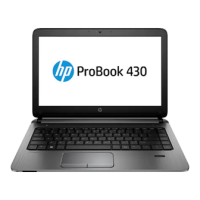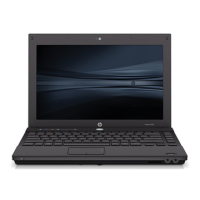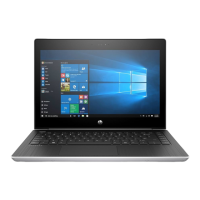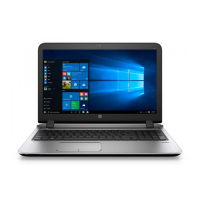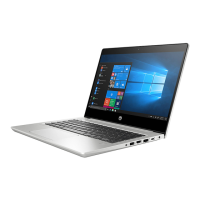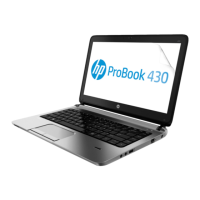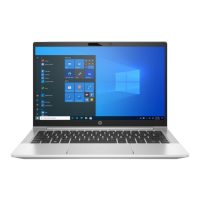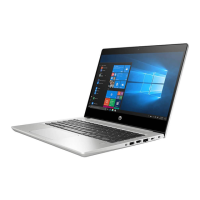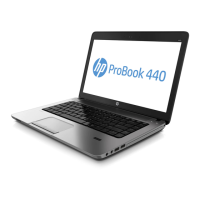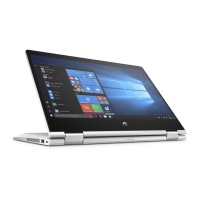Do you have a question about the HP ProBook 4330s and is the answer not in the manual?
Lists the names of the HP ProBook models covered in the manual.
Details the available Intel processor options for each model.
Lists the graphics options available for the HP ProBook models.
Details memory configurations, speeds, and module slots.
Lists available SATA hard drive types and capacities for the computers.
Lists all available input/output ports on the computer.
Details keyboard and touchpad features and functionality.
Lists AC adapter and battery specifications.
Lists the preinstalled operating systems available for the models.
Lists components that are replaceable by the end-user.
Identifies external display components and their functions.
Identifies TouchPad buttons and their functions.
Explains the function of various indicator lights on the computer.
Identifies power, QuickWeb, wireless buttons, and fingerprint reader.
Identifies various keys like Esc, Fn, Num Lock, and their functions.
Identifies front-panel components like drive lights, card reader, and audio jacks.
Identifies left-side components like security slot, AC adapter light, power connector, and ports.
Identifies right-side components like USB ports, modem jack, and optical drive.
Identifies bottom components like battery latches, SIM slot, and access door.
Explains the purpose and information found on the service tag.
Provides an exploded view of the computer's main internal parts.
Lists spare part numbers for system boards based on region and features.
Lists spare part numbers for various processors.
Lists required tools and general service considerations for component replacement.
Lists specific tools needed for component replacement procedures.
Precautions for handling fragile drive components to prevent damage.
Explains the importance of ESD and proper grounding for component safety.
Provides removal and installation steps for the computer battery.
Instructions for removing and replacing the bottom access door.
Instructions for removing and replacing the computer's hard drive.
Instructions for removing and installing memory modules.
Instructions for removing and installing the computer keyboard.
Instructions for removing and installing the computer's processor (CPU).
Instructions for removing and installing the computer's top cover.
Instructions for removing and installing the computer's system board.
Instructions for removing and installing the computer's display assembly.
Explains what Computer Setup (BIOS) controls and its functions.
Steps to reset BIOS settings to factory defaults.
Information on how to find and update the system BIOS.
Overview of diagnostic tests for checking computer hardware functionality.
General physical and environmental specifications of the computer.
Detailed specifications for the 13.3-inch HD display.
Detailed specifications for the 14.0-inch HD display.
Technical specifications for various hard drive capacities.
Overview of backup and restore options for Windows 7.
Detailed steps and notes for backing up data and system settings.
Introduces recovery tools for system failure and instability.
Instructions for using the f11 recovery tool to restore the system.
Overview of backup and restore options for Windows Vista.
General requirements for power cords applicable worldwide.
Country-specific power cord requirements and agency approvals.
Guidelines for safe disposal of used computer batteries.
Safety warnings and disassembly overview for the display assembly.
Lists the names of the HP ProBook models covered in the manual.
Details the available Intel processor options for each model.
Lists the graphics options available for the HP ProBook models.
Details memory configurations, speeds, and module slots.
Lists available SATA hard drive types and capacities for the computers.
Lists all available input/output ports on the computer.
Details keyboard and touchpad features and functionality.
Lists AC adapter and battery specifications.
Lists the preinstalled operating systems available for the models.
Lists components that are replaceable by the end-user.
Identifies external display components and their functions.
Identifies TouchPad buttons and their functions.
Explains the function of various indicator lights on the computer.
Identifies power, QuickWeb, wireless buttons, and fingerprint reader.
Identifies various keys like Esc, Fn, Num Lock, and their functions.
Identifies front-panel components like drive lights, card reader, and audio jacks.
Identifies left-side components like security slot, AC adapter light, power connector, and ports.
Identifies right-side components like USB ports, modem jack, and optical drive.
Identifies bottom components like battery latches, SIM slot, and access door.
Explains the purpose and information found on the service tag.
Provides an exploded view of the computer's main internal parts.
Lists spare part numbers for system boards based on region and features.
Lists spare part numbers for various processors.
Lists required tools and general service considerations for component replacement.
Lists specific tools needed for component replacement procedures.
Precautions for handling fragile drive components to prevent damage.
Explains the importance of ESD and proper grounding for component safety.
Provides removal and installation steps for the computer battery.
Instructions for removing and replacing the bottom access door.
Instructions for removing and replacing the computer's hard drive.
Instructions for removing and installing memory modules.
Instructions for removing and installing the computer keyboard.
Instructions for removing and installing the computer's processor (CPU).
Instructions for removing and installing the computer's top cover.
Instructions for removing and installing the computer's system board.
Instructions for removing and installing the computer's display assembly.
Explains what Computer Setup (BIOS) controls and its functions.
Steps to reset BIOS settings to factory defaults.
Information on how to find and update the system BIOS.
Overview of diagnostic tests for checking computer hardware functionality.
General physical and environmental specifications of the computer.
Detailed specifications for the 13.3-inch HD display.
Detailed specifications for the 14.0-inch HD display.
Technical specifications for various hard drive capacities.
Overview of backup and restore options for Windows 7.
Detailed steps and notes for backing up data and system settings.
Introduces recovery tools for system failure and instability.
Instructions for using the f11 recovery tool to restore the system.
Overview of backup and restore options for Windows Vista.
General requirements for power cords applicable worldwide.
Country-specific power cord requirements and agency approvals.
Guidelines for safe disposal of used computer batteries.
Safety warnings and disassembly overview for the display assembly.
| HDD speed | 7200 RPM |
|---|---|
| HDD interface | SATA II |
| Optical drive type | DVD Super Multi DL |
| Card reader integrated | Yes |
| Total storage capacity | 320 GB |
| Memory slots | 2x SO-DIMM |
| Internal memory | 4 GB |
| Memory clock speed | 1333 MHz |
| Internal memory type | DDR3-SDRAM |
| Maximum internal memory | 8 GB |
| Bus type | DMI |
| Stepping | J1 |
| Tjunction | 100 °C |
| Processor cache | 3 MB |
| Processor cores | 2 |
| Processor model | i5-2410M |
| System bus rate | 5 GT/s |
| Processor family | Intel® Core™ i5 |
| Processor series | Intel Core i5-2400 Mobile Series |
| Processor socket | BGA 1023 |
| Processor threads | 4 |
| Processor codename | Sandy Bridge |
| Processor frequency | 2.3 GHz |
| Processor cache type | Smart Cache |
| Processor lithography | 32 nm |
| Processor manufacturer | Intel |
| Processor front side bus | - MHz |
| PCI Express slots version | 2.0 |
| Processor boost frequency | 2.9 GHz |
| Processor operating modes | 64-bit |
| ECC supported by processor | No |
| PCI Express configurations | 1x8, 1x16, 2x4, 2x8 |
| Thermal Design Power (TDP) | 35 W |
| CPU multiplier (bus/core ratio) | 23 |
| Maximum number of PCI Express lanes | 16 |
| Display surface | Matt |
| Display diagonal | 13.3 \ |
| Display resolution | 1366 x 768 pixels |
| Native aspect ratio | 16:9 |
| Power supply type | AC/DC |
| Intel segment tagging | Enterprise |
| Audio system | Premium Sound |
| Bluetooth version | 3.0+HS |
| Cabling technology | 10/100/1000Base-T(X) |
| Networking features | Gigabit Ethernet |
| Operating system installed | Linux |
| Charging port type | DC-in jack |
| USB 2.0 ports quantity | USB 2.0 ports have a data transmission speed of 480 Mbps, and are backwards compatible with USB 1.1 ports. You can connect all kinds of peripheral devices to them. |
| Firewire (IEEE 1394) ports | 0 |
| Battery life (max) | 6 h |
| Number of battery cells | 6 |
| AC adapter power | 65 W |
| Operating temperature (T-T) | 5 - 35 °C |
| Sustainability certificates | ENERGY STAR |
| Product color | Black |
| Housing material | Aluminum |
| Country of origin | China |
| Pointing device | Touchpad |
| On-board graphics card ID | 0x116 |
| Discrete graphics card model | Intel® HD Graphics 3000 |
| On-board graphics card family | Intel® HD Graphics |
| On-board graphics card base frequency | 650 MHz |
| On-board graphics card dynamic frequency (max) | 1200 MHz |
| Processor ARK ID | 52224 |
| Processor package size | 37.5x37.5 (rPGA988B); 31 x 24 (BGA1023) mm |
| Supported instruction sets | AVX |
| Intel Identity Protection Technology version | 1.00 |
| Depth | 235 mm |
|---|---|
| Width | 330 mm |
| Height | 27.9 mm |
| Weight | 2000 g |
